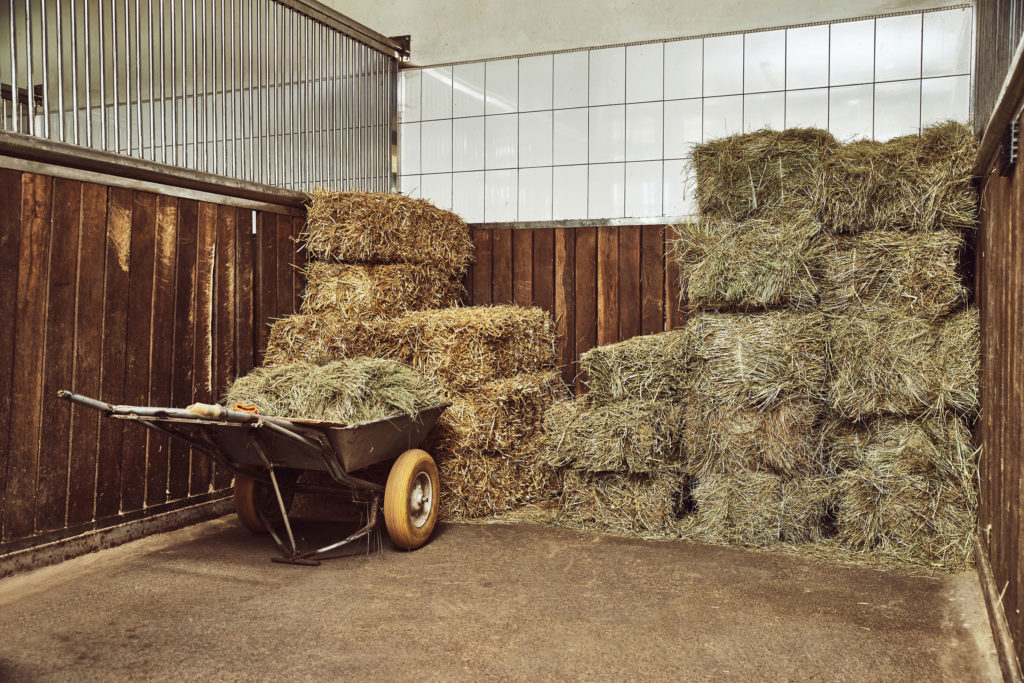
The basic foundation of any equine diet is forage. While owners often feed hardworking horses, mares with foals, young horses, or any other individuals that need additional calories grain and concentrates, forage should remain the foundation of their diet.
Many types of hay are available for horses. The best one for your horse varies depending on your region (certain types of hay grow better in different climates) and the needs of your individual horse.
Krishona Martinson, PhD, professor and equine extension specialist in the Department of Animal Science at the University of Minnesota, in Minneapolis, says the most effective way to know the quality of your hay is to have it tested.
“A hay analysis is affordable (about $20 per sample) and will show the amount of equine digestible energy, crude protein, fiber components, moisture, nonstructural carbohydrates, calcium, and phosphorus,” she says. “For an additional fee, more minerals and vitamins can be included in the analysis, as well as mold counts.”
Horse owners can also physically evaluate hay to determine its forage type, maturity, texture, smell, color, and presence of mold and toxic weeds. Owners should consider where the hay was harvested (local or out of state) and potential rainfall, says Martinson.
“We have published research on different round-bale wrap types,” she says. “We found that when round bales were stored outdoors for 12 months, dry matter losses were 7% for twine tied bales, 5% for net wrapped bales, while B-Wrap bales maintained dry matter.” Because dry matter is what you are buying and feeding, it’s important to preserve it.
Types of Hay for Horses
The three major hay types are legume, cool-season grass, and warm-season grass. “Legumes tend to be higher in crude protein, energy, and calcium, lower in fiber values, and moderate in nonstructural carbohydrates,” says Martinson. “Because of this, they are best suited for horses with higher nutritional requirements, including performance horses and lactating mares.”
Cool-season grasses typically have a moderate level of crude protein, energy, and fiber, and are lower in calcium but higher in nonstructural carbohydrates than legumes. This makes cool-season grasses useful for a wide variety of horses, including those in moderate exercise.
Warm-season grasses tend to be higher in fiber values and lower in crude protein, energy, calcium, and non–structural carbohydrates. “Like cool-season grasses, they can be fed to a wide range of horses, but are especially useful when feeding idle horses, easy keepers, or horses who need a lower non–structural carbohydrate forage such as horses with laminitis or equine metabolic syndrome,” says Martinson.
Hay for Horses: Maturity
Another important consideration is maturity, a major factor in determining forage quality. Mature forage can be characterized by visible seed heads on grass hays or flowers on legumes and will be higher in fiber but lower in crude protein and energy levels, she adds. Mature hay is ideal for easy keepers and idle horses.
One easy way to assess the maturity of alfalfa hay is with a snap test. If a handful of the hay bends easily in your hand, its fiber content is relatively low and the hay will be more digestible than if the stems snap like twigs.
Hay that was rained on when cut and redried before baling will be dull in color, typically yellow or brown, rather than bright green. However, most hay tends to weather because the sun bleaches the outside of the bales. You often cannot determine the quality of the hay by looking at the outside. The inside should still be green, even if the outer edge has faded to a yellow-tan from exposure to sun and rain. If the hay inside the bale is dull and brown rather than green, it has probably lost much if its nutritional value.
Take-Home Message
The quality of the hay you choose for your horse is important for his overall well-being. Choosing a type of hay that fits his activity level and nutritional needs will ensure he receives the nutrients he needs without being overfed, which could put him at risk of being overweight or developing metabolic problems. Being able to visually identify the general quality of the hay and sending hay for analysis can also help horse owners better understand what their horses are consuming.



